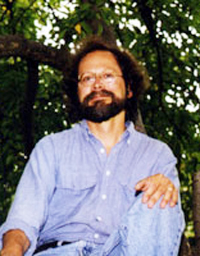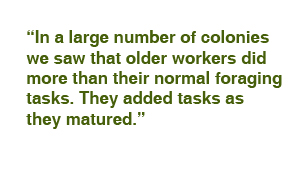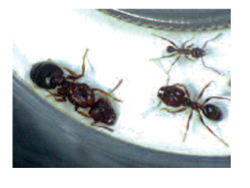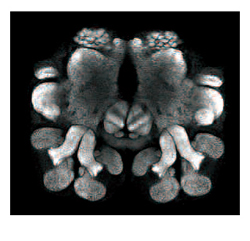Learning to Adapt
 James Traniello: Nurses, Foragers, and Soldiers James Traniello: Nurses, Foragers, and Soldiers
In many ant species, age correlates with an individual’s role in the colony. Young ants of the worker caste toil within the nest, while older ants leave the nest for riskier tasks. Biologists have assumed that such behavior is programmed: that age-related changes are caused by neural and physiological development, and as ants age, they shift among non-overlapping tasks. But, according to biologist James Traniello, this might not be the whole story.
Traniello studies the behavior and neurobiology of the ant Pheidole dentata for clues to how social insects divide labor among colony members. P. dentata is a completely dimorphic species, meaning that workers are either minors who perform most labor within a colony, or majors who, with their large heads and strong mandibles, are primarily defenders and food processors. In the paradigm, young minors specialize in brood care. “They’re basically nurses,” says Traniello. At about twenty days old, they start foraging. Task sets are thought to be segregated, he explains. “Nurses are only nurses and foragers are only foragers. But we’ve found that the traditional model might not be correct.”
 Traniello observed that the minors start as nurses but retain the ability to perform nursing tasks as they age. “In a large number of colonies we saw that older workers did more than their normal foraging tasks. They added tasks as they matured,” he says, “undergoing up to a six-fold increase in tasks from day one to day twenty.” His research showed that young ants with weak mandible muscles are ill-suited for riskier tasks. “They’re simply not ready to work efficiently, so as they mature they add more work as they are able.” Traniello has also experimentally removed members of a colony and shown that ants take over the roles of the missing castes. “They switch tasks almost immediately,” he says, suggesting that they are readily able to perform a variety of jobs. Traniello observed that the minors start as nurses but retain the ability to perform nursing tasks as they age. “In a large number of colonies we saw that older workers did more than their normal foraging tasks. They added tasks as they matured,” he says, “undergoing up to a six-fold increase in tasks from day one to day twenty.” His research showed that young ants with weak mandible muscles are ill-suited for riskier tasks. “They’re simply not ready to work efficiently, so as they mature they add more work as they are able.” Traniello has also experimentally removed members of a colony and shown that ants take over the roles of the missing castes. “They switch tasks almost immediately,” he says, suggesting that they are readily able to perform a variety of jobs.
 Together with graduate student Mario Muscedere and undergraduates Tara Willey and Jennifer Berglund, Traniello is studying P. dentata and other ants to determine if age- and size-related behaviors are correlated with neurology. In recent work, graduate student Marc Seid found that levels of the neurotransmitters dopamine and serotonin increased as minor workers matured. He also found age-correlated changes in the connectivity and strength of synapses, the message-trafficking connections between neurons. “This is the pattern in many organisms; they start with synapses, then prune them. We found that ants were doing the same thing, supporting our hypothesis that they gain abilities Together with graduate student Mario Muscedere and undergraduates Tara Willey and Jennifer Berglund, Traniello is studying P. dentata and other ants to determine if age- and size-related behaviors are correlated with neurology. In recent work, graduate student Marc Seid found that levels of the neurotransmitters dopamine and serotonin increased as minor workers matured. He also found age-correlated changes in the connectivity and strength of synapses, the message-trafficking connections between neurons. “This is the pattern in many organisms; they start with synapses, then prune them. We found that ants were doing the same thing, supporting our hypothesis that they gain abilities  as they grow by refining neural connections.” As he continues to correlate ant behavior with neurobiology, Traniello hopes to better understand the remarkable adaptability of insect behavior and the source of their complex social structure. as they grow by refining neural connections.” As he continues to correlate ant behavior with neurobiology, Traniello hopes to better understand the remarkable adaptability of insect behavior and the source of their complex social structure.
This research appeared in the September 2006 issue of Behavioral Ecology and Sociobiology.
For more information, visit www.bu.edu/biology/Faculty_Staff/jft.html
— by Leah Eisenstadt |






 James Traniello: Nurses, Foragers, and Soldiers
James Traniello: Nurses, Foragers, and Soldiers  Traniello observed that the minors start as nurses but retain the ability to perform nursing tasks as they age. “In a large number of colonies we saw that older workers did more than their normal foraging tasks. They added tasks as they matured,” he says, “undergoing up to a six-fold increase in tasks from day one to day twenty.” His research showed that young ants with weak mandible muscles are ill-suited for riskier tasks. “They’re simply not ready to work efficiently, so as they mature they add more work as they are able.” Traniello has also experimentally removed members of a colony and shown that ants take over the roles of the missing castes. “They switch tasks almost immediately,” he says, suggesting that they are readily able to perform a variety of jobs.
Traniello observed that the minors start as nurses but retain the ability to perform nursing tasks as they age. “In a large number of colonies we saw that older workers did more than their normal foraging tasks. They added tasks as they matured,” he says, “undergoing up to a six-fold increase in tasks from day one to day twenty.” His research showed that young ants with weak mandible muscles are ill-suited for riskier tasks. “They’re simply not ready to work efficiently, so as they mature they add more work as they are able.” Traniello has also experimentally removed members of a colony and shown that ants take over the roles of the missing castes. “They switch tasks almost immediately,” he says, suggesting that they are readily able to perform a variety of jobs. Together with graduate student Mario Muscedere and undergraduates Tara Willey and Jennifer Berglund, Traniello is studying P. dentata and other ants to determine if age- and size-related behaviors are correlated with neurology. In recent work, graduate student Marc Seid found that levels of the neurotransmitters dopamine and serotonin increased as minor workers matured. He also found age-correlated changes in the connectivity and strength of synapses, the message-trafficking connections between neurons. “This is the pattern in many organisms; they start with synapses, then prune them. We found that ants were doing the same thing, supporting our hypothesis that they gain abilities
Together with graduate student Mario Muscedere and undergraduates Tara Willey and Jennifer Berglund, Traniello is studying P. dentata and other ants to determine if age- and size-related behaviors are correlated with neurology. In recent work, graduate student Marc Seid found that levels of the neurotransmitters dopamine and serotonin increased as minor workers matured. He also found age-correlated changes in the connectivity and strength of synapses, the message-trafficking connections between neurons. “This is the pattern in many organisms; they start with synapses, then prune them. We found that ants were doing the same thing, supporting our hypothesis that they gain abilities  as they grow by refining neural connections.” As he continues to correlate ant behavior with neurobiology, Traniello hopes to better understand the remarkable adaptability of insect behavior and the source of their complex social structure.
as they grow by refining neural connections.” As he continues to correlate ant behavior with neurobiology, Traniello hopes to better understand the remarkable adaptability of insect behavior and the source of their complex social structure.